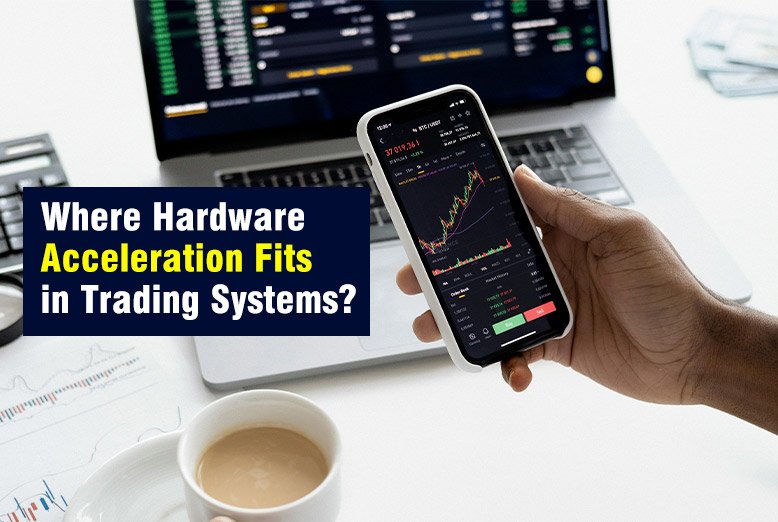Seconds once determined the outcome in trading. But that’s changed. Today, financial markets operate at a scale where even nanoseconds can separate profit from loss. Specialized chips now process market data faster than computers. So, what’s driving this race to the fastest possible solutions?
The Shift to Silicon in Trade Execution
Trading systems relied on processors and complex software stacks. This was sufficient when market speeds allowed for human decision-making. However, as electronic trading matured, systems built on CPUs hit technological limits that software tweaks simply couldn’t overcome.
Why do these limits exist? CPUs are designed for versatility, running countless programs with sequential instruction processing. But this flexibility comes with unpredictability. Delays can get in through operating system interrupts, and memory cache misses. Engineers tried to cut down on these delays but the core problem persisted: the trading logic was still running on general-purpose processors, prone to unpredictable timing.
A breakthrough came from a new computing architecture. Field-Programmable Gate Arrays (FPGAs) allowed trading logic to run as custom hardware circuits, while remaining reconfigurable as markets and protocols evolved. Instead of relying on software running on CPUs, FPGAs deliver consistent, highly predictable timing measured in nanoseconds
Matching the Right Accelerator to the Right Trading Task
Not every trading function needs the same hardware. Modern trading systems now use different processors, each geared for specific computational demands. Determining which accelerator fits each task is essential for building an effective system.
Here’s how each major hardware option generally fits into a trading infrastructure:
– CPUs: Still indispensable for high-level strategy management, complex non-time-sensitive calculations, and overall system coordination. Their strength lies in flexibility. Ideal for developing new algorithms, managing elaborate risk models, and orchestrating broad platform activities.
– GPUs: Shine when mass parallelism is needed. While originally designed for graphics, GPUs thousands of cores efficiently handle machine learning training, massive risk calculations, and backtesting. But their benefits are balanced by the overhead of system communication, meaning they’re not the best fit for latency-critical tasks in live trading.
– FPGAs: Hit the sweet spot when ultra-low latency and reconfigurability are vital. FPGAs process trading functions as dedicated hardware circuits, giving deterministic, parallel performance.
– ASICs: Push specialization even further. These chips are built for single functions, achieving the lowest latency possible. But with no flexibility to adapt, any shift in market protocols or rules can render them obsolete, making them practical only for the largest players with exceptionally stable, high-volume strategies.
Cost-Conscious Paths to Hardware Acceleration
Adopting hardware acceleration involves far more than buying chips. Organizations must weigh competitive advantages against significant investments in technology and expertise.
Building an in-house FPGA capability means hiring engineers skilled in hardware design. These experts command salaries, and end-to-end system development can take months or longer. Costs also include software tool licenses, hardware, and ongoing maintenance as market needs evolve.
For many trading firms, working with specialized vendors provides a more practical avenue. Magmio (www.magmio.com) offers end-to-end FPGA trading solutions that streamline development. The system supports everything from market data processing to risk checks and order logic, while C++ APIs allow traders to adjust strategies easily, without requiring specialized hardware skills. This approach reduces deployment time and technical barriers, enabling teams to focus on strategy, not hardware intricacies.
It’s also crucial to assess the risks. Technology and market requirements change quickly, and hardware acceleration investments must consider potential shifts in protocols and regulations. FPGA reconfigurability offers protection, but dedicating resources to these platforms represents a long-term commitment.
FPGA in Action: Rewriting the Rules of Market Response
FPGA solutions fundamentally transform trading workflows from end to end. Market data ingestion illustrates the biggest leap. In other setups, data often passes through the OS network stack, CPU parsing software, and finally into trading models. Each step adds latency and unpredictability. FPGA-based systems ingest raw network data, decode exchange protocols, and update order books. All in one system, almost in real-time.
The results are striking. Software-based solutions process market data in microseconds; FPGAs do it in tens of nanoseconds. More importantly, the process is fully predictable, input in, output out, always on the same schedule. This consistency eliminates the timing “jitter” that plagues fast trading in software-based systems.
What about risk management? Regulatory requirements mandate that orders pass multiple pre-trade risk checks before reaching exchanges. On CPUs, these checks increase critical path latency or require complex system architectures. With FPGAs, many risk validations can run concurrently as data streams through the chip, protecting system speed.
Order execution is similarly transformed. When a trading opportunity arises, the process from signal detection to order transmission occurs entirely in hardware, achieving ultra-low tick-to-trade latency.
Hardware acceleration has fundamentally transformed electronic trading, moving vital functions from flexible-but-slow software to dedicated circuits engineered for speed. The right technology choice depends on individual functional needs. FPGAs have become the clear leaders in ultra-low-latency operations, balancing speed, reliability, and adaptability. CPUs and GPUs retain important roles, but the fastest components increasingly depend on hardware-based solutions for a lasting edge.
Also read ; The Secret to Successful Trading Without the Stress







